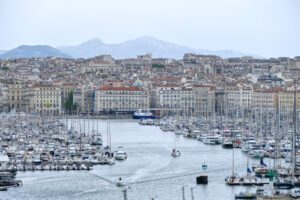I’m well aware that the French Provence region is rather famous for picturesque villages and endless lavender fields. Well, you won’t find either in this post. I just can’t help it: I’m a big city gal, and therefore, on my first trip to this part of the south of France, I decided to visit five of the best cities the Provence has to offer. In Nîmes, I hunted for street art, and I traced the work of Vincent van Gogh in Arles. I danced sur le pont d’Avignon and enjoyed the much-underrated city of Aix-en-Provence. Finally, I explored the mother of all port cities, Marseille.

No, I didn’t get to see any lavender, however, I saw amazing old and new works of art and fantastic architecture. I strolled through alleys, sat in squares, and took it all in. The sound of the sea and the calls of the fishmongers rang in my ears. I was in a French land of milk and honey wine and bouillabaisse.
I had a fantastic time and I’ll be certainly back. And then, I’ll also go check out the lavender.
Bienvenue en Provence
Provence is idyllically located on the Mediterranean between the Rhône Valley and Italy in the southeast of France. The name comes from the time of Roman rule, from the Latin provincia. It was one of the first and most heavily Romanized regions outside of Italy, which is still reflected in many ancient treasures today. Many of the sights are on the list of world cultural and natural heritage. For example, Arles was an important trading center in Roman times, and the amphitheater is still used as a bullring today. The Romanesque church of Saint Trophime d’Arles was a cathedral for six centuries before the episcopal see was moved to Aix-en-Provence during the French Revolution.

The Pont du Gard is a Roman aqueduct over the Gardon and was previously used to supply water to the city of Nîmes. Although Nîmes is not strictly speaking part of Provence, the city is often included.
The old town of Avignon is surrounded by the twelfth-century city walls. In addition to many churches and medieval buildings, the Pope’s Palace is the city’s most impressive sight.

In particular, Provence is associated worldwide with breathtaking natural beauty, especially the endless lavender fields. But the Massif des Calanques south of Marseille is also a popular place of longing, with some deep, fjord-like bathing bays.
Provençal cuisine is also celebrated, with world-famous dishes such as bouillabaisse and ratatouille being an integral part.
The addition to dishes à la Provence usually means tomato sauce with special local herb mixtures, eggplant, zucchini, peppers, and olive oil. All of these are products grown in Provence and available at the colorful farmers markets.
Literally Literary Fantastical
Ever since reading Marcel Pagnol’s novels, which – including his moving childhood memories – are all set in Provence, this region has been a place of longing for me for ages. It is therefore difficult to explain that it was only a few weeks ago that I checked for the first time whether this part of France actually holds up to what Pagnol promised me in his books decades ago.
I can assure you: It does!

Although I unfortunately only had a total of just under a week for my trip, I was able to convince myself in five cities that Provence is definitely worth a trip. In individual posts, I have put together what I liked most about my flying visit to the cities Arles, Nîmes, Avignon, Aix-en-Provence, and Marseille – and that was quite a lot! Since the time for the city trip was already quite tight, there was, unfortunately, no time for the natural beauties outside of the cities, apart from the view from the train or the intercity bus.
But that will definitely be fixed soon.
Provence is worth much more than just a trip!
ARLES
I landed at the Marseille-Provence Airport and took a regional train to Arles right away. This made it the first stop of my circle tour, obviously.
Arles is very idyllically located on the river Rhône. This privileged location bedazzled already the ancient Romans, hence, they made it a provincial capital. This is why Arles has the largest number of Roman monuments – after Rome, of course. Arenas and Cryptoporticos date back to the 1st century BC. In the 4th century, another heyday brought Arles iconic landmarks such as the Constantine Baths and the necropolis of Alyscamps. Also, to this date, theater plays, concerts, and even bullfights are staged at the city’s amazing Roman theaters.

Much later, namely, in the 11th and 12th centuries, Arles became one of the most important cities in the Mediterranean world. The city was Christianized early on and became an essential stop on the Way of St. James. Within the mighty city walls stands the former Saint Trophime Cathedral with the conjoined monastery. Also, the famous Montmajour Abbey is close to the city center. Both monuments are momentous examples of Provençal Romanesque architecture.
Vincent
Finally, in the 19th century, one of the greatest painters of all time lived in Arles. As is well known, Vincent van Gogh was not particularly respected as an artist during his lifetime and the residents of Arles in particular had strong reservations about their new neighbor. Therefore, it was only later that the city began to boast about its now-celebrated guest. Van Gogh created around 300 works during his stay in Arles, including his most famous ones such as The Starry Night, Café Terrace at Night, Bridge of Langlois, as well as various paintings of his Bedroom.

As I said above, the artist came to Arles in 1888 for the warm light illuminating the city supposedly for almost 3,300 hours every year.

Given that Arles is home to only a bit over 50,000 inhabitants, one might expect a serene, maybe even a bit sleepy provincial town.
Well, one is so wrong!
Arles might not be large but it has at least as many landmarks, museums, and other amazing places as many international metropolises.
Once in Arles, you need to
- walk in the footsteps of the ancient Romans
- explore what fascinated Vincent van Gogh in the city
- visit the Saint Trophime Cathedral and the Cloister
- enjoy a snack at the Épicerie Le Cloître
- admire the LUMA Parc des Ateliers
But there is much more to explore – as you can read in my post.
NÎMES
The next morning, I continued from Arles to Nîmes by regional train which took only about twenty minutes.
The city of Nîmes has so much fascinating history that it’s actually hard to understand why it isn’t a bigger tourist magnet. Yes, the city has two prominent highlights nearby: Arles, world-famous thanks to Vincent van Gogh’s paintings, and the former papal residence Avignon. But that shouldn’t stop you from visiting this hidden gem, especially since the two supposed competitors are only half an hour away.

Nîmes was founded around 500 BC, and Emperor Augustus made it the regional capital. This gave the city not only one of the longest defensive walls in the Roman world. In addition, with the Pont du Gard, the city got a 30-mile-long aqueduct to supply water to the growing population. Today, the aqueduct, which is about 25 kilometers northeast of the city, is listed as a UNESCO World Heritage Site.
However, the core of Roman Nîmes was a temple called the Maison Carrée. This temple competes with the Pantheon in Rome as the most complete and magnificent surviving structure of the Roman Empire.
When in Rome Nîmes…
While Nîmes is primarily known for its Roman sights, the city also offers a lot of other beautiful things. There is a pretty, traffic-calmed old town with picturesque streets lined with elegant houses and many idyllic squares.

In the warm sunshine of Provence, a walk through the Jardin de la Fontaine is wonderfully relaxing. The sprawling, elegant park consists of an elaborate network of canals and paths and is full of Baroque sculptures. The garden was completed just 50 years after Versailles was built. Its peculiarity is that it was one of the first large gardens created not for a king, but for the common people.
But don’t think that the Canal de la Fontaine was built so you can enjoy a walk on its banks. It was originally used to operate mills and soak wool, silk, and cotton during the process of textile production.
At the end of the 17th century, textile production made Nîmes the leading French city for hosiery, woolen fabrics, and shawls. Those were exported throughout Europe and far beyond.

It was in the center of Nîmes where the industrialist Joseph André traded in silk and serge, twill in English. Twill from Nîmes, hence, in French Serge de Nîmes.
De Nîmes. Denim.
Hence, it was the French who first produced this robust material. They sought to recreate Jeane, a durable cotton corduroy made in the Italian city of Genoa in the 16th century.
Jeane. Jeans.
Once in Nîmes, you need to
- walk on the ancient rocks of the Roman Amphitheater
- visit the Maison Carrée and the Carré d’Art
- stroll through the Jardins de la Fontaine
- explore the street art in the districts of Gambetta and Richelieu
- sample Brandade, the traditional cod gratin
But there is much more to explore – as you can read in my post.
AVIGNON
You probably have heard of Avignon. Everybody does, albeit mostly for the wrong reason, namely this dancing song.

When preparing for my trip to Provence, I was amazed at what awaited me in this city. Not only had Avignon been the seat of Popes, it is also known far beyond France for its annual theater festival. Avignon was also the European Capital of Culture in 2000.
Due to the strong Catholic presence in the past centuries, the number of religious buildings is quite impressive. Also, I heard about painted windows and an incredible number of little patron saints on literally every corner. Avignon is called the city of the popes, the city of theater, the city of murals, and the city of Marian figures.

Oh yes, and then there is the bridge.
Popes in Avignon
Today, we take it for granted that the Pope is Catholic has his seat in Rome, hence, hardly anyone realizes that for several decades, Avignon was the base of the Pontifex Maximus. During the time of the influential French King Philip IV, Cardinal Clement V was elected pope in 1305 and held that job until 1314. However, in 1309 he moved his residence to Avignon.
It was not until 1378 that another papal election took place in Rome. Nonetheless, until 1429, there still remained several antipopes in Avignon, Peñíscola, and Armagnac.

In total, nine popes inhabited the magnificent papal palace in Avignon. To this date, it is nicknamed the City of the Popes, and the palace remains a symbol of the prestige of Christianity. It is the most important Gothic building ever created. With its 15,000 square meters, it is the size of four regular Cathedrals, after all!

Once in Avignon, you need to
- visit the Papal Palace and its gardens
- admire famous masterpiece in the Petit Palais Museum
dancewalk sur le pont d’Avignon- marvel at the amazingly painted windows
- spot as many Marian statues as you can
But there is much more to explore – as you can read in my post.
AIX-en-PROVENCE
Arles has the Roman amphitheater, Avignon has the former papal palace, and Marseille’s landmarks are spread over many square kilometers. Phew, as inspiring as a tour of the Provence is, at some point, it also becomes exhausting.
And then you get to Aix-en-Provence.

Strolling along the Cours Mirabeau just above the glorious Place de la Rotonde, you pass cafés on whose terraces people are chatting in the early morning sun or cozily reading today’s newspaper. The old-fashioned, decelerated printed version. In front of them, the waters of the quirky Fontaine Moussue are softly gurgling. Even they emit peace and comfort as they leisurely drop from the moss into the pool.
Wells, Wellness, And Wealth
Aix owes its beautiful name to the thermal springs that existed as early as 123 BC when the Romans founded the city. They called it Aquae Sextiae, whereby Aquae naturally goes back to the thermal springs. Over time, it became Aix.
To this day, the city is proud of its thermal baths and uncountable fountains, but also of its more than 300 days of sunshine a year.

Aix-en-Provence was the capital of Provence in the 15th century. With the rise of Marseille to become the regional center and capital of the newly created department of Bouches-du-Rhône, Aix lost its political importance. The university founded by Ludwig II closed some of its faculties, and the parliament was converted into a courthouse.
Despite the loss of political importance, numerous noble families built their city palaces in Aix in the 17th and 18th centuries. The magnificent buildings in the Baroque style still characterize the city today.
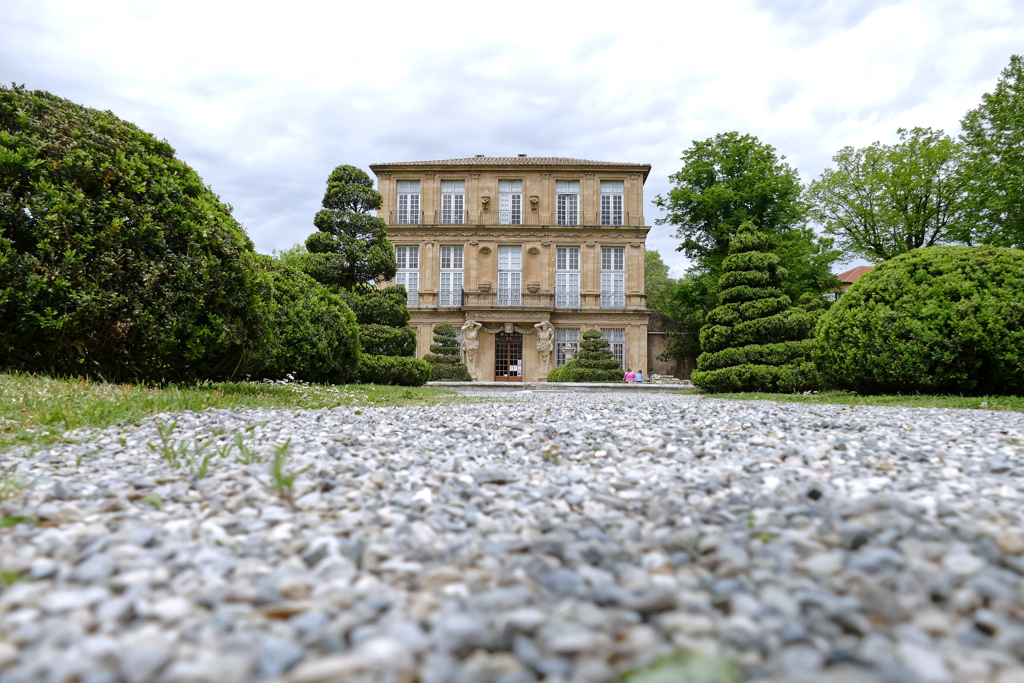
The city also continued to attract painters and writers.
It was the birthplace of the post-impressionist artist Paul Cézanne. To this day, you can follow in his footsteps along a hiking trail and visit his childhood home, the so-called Jas de Bouffan, as well as his former studio. But the city also captivated grandmasters of literature and art such as Paul Guigou, Émile Zola, and Marie-Henri Beyle, better known by his pseudonym Stendhal, and inspired them to create some of their most important chef-d’oeuvres.
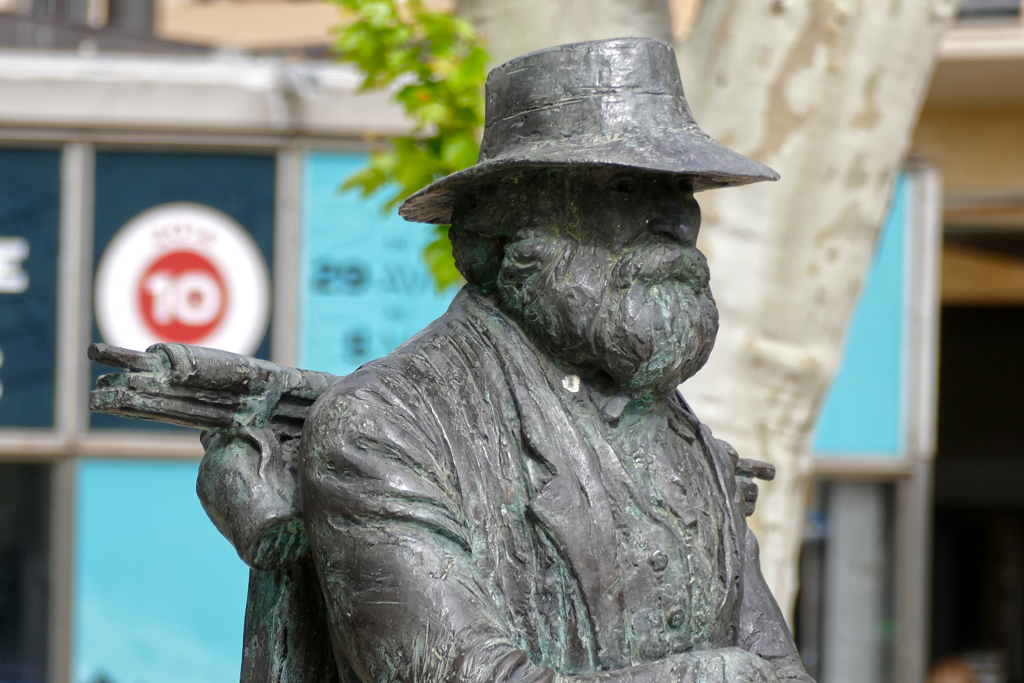
You see, Aix doesn’t need to advertise itself blatantly. It can sit back and relax and let the illustrious past reflect on its inspiring presence and promising future.
Once in Aix-en-Provence, you need to
- enjoy a second breakfast at one of the cafés alongside the stately Cours Mirabeau
- admire grand art at the Musée Granet
- see how the other half lived at the Hôtel de Caumont
- visit as many fountains in as many squares as you possibly can
- end the day enjoying an Apéritif at one of the bars around Place Richelme
But there is much more to explore – as you can read in my post.
MARSEILLE
Marseille is a port city that has been around for a while. In fact, it is the oldest city in France and has always been a major hub for immigration and sea trade. Consequently, its heart is the Vieux-Port where fishmongers sell their catch fresh off the boat to this date.
For me, Marseille has always been a myth, a place of longing. Marseille awakens wanderlust, yet at the same time, it makes you homesick. It is a city full of contrasts and contradictions.

As Marseille is France’s gateway to the Mediterranean, it is characterized by immigrants like hardly any other French metropolis. In the period around 1900, these were mainly Italians. After the Second World War, they were joined by Algerian-French people of European descent and residents of the former French colonies.

When taking the earliest immigration movements into account, 90 percent of the population has ancestors who did not come from France.
A City for All the Senses
A wistful, melancholic air blows around the city. When strolling through the old harbor where fish are still sold in the market on the quays, you can still feel the rough charm of the hard-working common people with their loud voices, calloused hands, and hearts of gold.

I do not want to hide the fact that Marseille has social and economic difficulties. Yet, you will see that the city of Marseille offers its visitors a verisimilitude that is sometimes missing for instance in globalized Paris. Also, the sociable attitude of locals and the multifarious cultural heritage make a visit to Marseille a unique experience.
Once in Marseille, you need to
- stroll around the basin of the Vieux Port
- visit the Museum of Civilizations of Europe and the Mediterranean MuCEM
- enjoy a panoramic view of the old center from the Parc Émile Duclaux
- explore the historic quarter of Le Panier
- gorge on a traditional Bouillabaisse
But there is much more to explore – as you can read in my post.
Practical Information
In this section, you’ll find general travel information and tips for the Provence region. In the individual posts on the cities I visited during my circle tour, you’ll get detailed recommendations that apply to those specific places.
How to Get There
Marseille-Provence Airport is the best hub when flying into the Provence region. It is located pretty much in the center of all five cities in the municipality of Marignane. Shuttle buses, so-called Navettes, take you straight to Aix-en-Provence and Marseille.
To get to Arles, Nîmes, or Avignon, you first need to take bus #13 from the airport’s Gare Routière to the train station Vitrolles. From there, take one of the regional trains whose number starts with TER.
By Train
There are train connections between the cities listed in this post as well as other metropolises in France and neighboring countries. Especially the high-speed train TGV is a great alternative if you don’t want to fly. You can get information and book tickets online on the website of the national train company SNCF.

Obviously, you can also buy your ticket at the station right before departure. However, I would only recommend this for short distances and travel on regional trains. Travelling by public transportation is very popular in France so trains tend to be either very full or, when a reservation is compulsory, even sold out.
How to Buy a Regional Train Ticket
Buying a ticket from a machine can be quite an adventure, especially if you’re a first-timer. That’s why I’m explaining the necessary steps below. You’ll see, it’s actually quite simple – once you know how to do it:

1. To select an option, spin the wheel and your selection will be highlighted in blue – this is what you will see in the next images.
Once the correct selection is highlighted in blue, press the Validez button in the middle. Then the next screen appears and you repeat the process until you see the final ticket on the screen as shown in the fifth picture.
2. To abort the process, press the Annulez button.
If you just want to access the former screen, you need to turn the wheel so that the green square in the left upper corner is highlighted. You see it in every picture below.
3. Now you can either pay contactless…
4. …or through the pad.
5. You can take your ticket and your receipts, if you have selected them, from this slot.





By Bus
Travelling by bus is getting really popular in Europe and in the Provence region, it can actually be much faster to take a long-distance bus than the train.
There are excellent bus connections between the cities listed in this post as well as other metropolises in France and neighboring countries. For short distances, the journey time by bus hardly differs from that by train, yet, it is cheaper. On longer routes, the train is much faster, but also significantly more expensive.
The bus terminals, the so-called Gare Routières, are conveniently located in the city center area, often right next to the main train stations.
How to Get Around
Apart from Marseille where the city center is quite large and some of the landmarks are in rather remote places, I was able to explore all the cities I visited on my circle trip by walking. Nevertheless, all of them have a comprehensive system of public transportation. Tickets are rather cheap and even included in some of the city passes.

Apart from Arles and Aix-en-Provence, there are city bikes to rent. Nevertheless, keep in mind that parts of Marseille and also Avignon are extremely hilly. Also, you won’t always find designated bike tracks, so you must maneuver between mindlessly meandering people. This being said, cycling is certainly a great activity as soon as you leave the crowded city centers behind.
Where to Stay
One of the great advantages of French centralism is that also those totally preposterous prices stay in the capital. As soon as you leave Paris, things get significantly cheaper and this applies to accommodation, too. Nevertheless, hotels tend to be pricey everywhere in France.
However, you don’t have to break the bank if you’re not insisting on staying at a cute boutique-style B&B or sleeping at a five-star hotel.
France has several hotel chains that are more focused on quantity than class. The most powerful player is certainly the Accor Group. Although they operate houses like Mercure and Pullman, they also run for instance Ibis Styles and Ibis Budget.
Accor Group properties are often clustered in the same spot, both in the city centers and outskirts. The Ibis Hotel** in Arles was about a fifteen-minute bus ride from the city center right on a motorway access road, while in Nîmes, the Ibis Styles** was directly opposite the train station. Overnight stays in these chain hotels will certainly not be one of your most unforgettable travel memories. But you get a clean room with everything you need at an affordable rate. In addition, you can have a good breakfast there at a reasonable price.
Make Yourself At Home
Another French peculiarity when it comes to accommodations are ApartHotels. I think the name gives away what these are, namely hotel rooms that are slightly larger and have also a well-equipped kitchenette. Although they are designed for long-term guests, the accommodations also offer affordable rates to travellers who only stay one or two nights. These inexpensive ApartHotels are often located a little outside the very center in non-touristy residential areas, which is not necessarily a bad thing. I stayed in Avignon at the ApartHotel Sainte-Marthe** just outside the old city walls next to the university, and in Marseille at the Appart’hôtel Odalys Le Dôme** in the Chartreux district north of the city center, just three subway stops from Saint Charles main station. Like I said, I wasn’t making memories, but I also didn’t cry when I looked at my credit card statements.
However, you can choose lodging options that suit your personal needs – and your budget, obviously, on Expedia*.
Visiting Organized
Although I’m an avid solo-travelling woman, I sometimes like to join organized tours especially if I don’t have much time to spare in a city. This way, I get comprehensive’n’condensed information, and it’s fun to visit landmarks in the company of like-minded fellow travellers.
Especially in summer, the Provence region can get quite busy. Therefore, booking tickets’n’tour ahead is certainly a good idea*:
What to Eat
French cuisine is famous all over the world for a reason. In fact, food is an important part of daily life in France and regional cuisines and customs are a cherished part of the national culture. UNESCO recognized France’s efforts and designated the country’s national cuisine as an intangible cultural heritage in 2010.
French dishes are famed for their sophistication and versatility and, most importantly, the high quality of the ingredients used. Of course, each region has its own specialties, but they are often popular throughout the country. The most famous dishes come from Normandy, Brittany, Burgundy, and the Provence region, obviously.
What’s Special?
Typical dishes in the Provence region are the fish soup bouillabaisse, the vegetable stew ratatouille, daube provençale, which is braised beef, as well as soupe au pistou a cold yet flavorful soup made with tons of garlic.

When dishes are called à la provençale, they usually include tomato sauce with the use of herbs, especially herbs from Provence, eggplant, zucchini, peppers, and olive oil, hence, ingredients that are grown in the region and sold on the many farmers markets that you’ll find everywhere.
Local specialties that also make wonderful souvenirs are Croquants Villaret, hence, almond cookies from Nîmes, and Calissons from Aix-en-Provence.

In addition to delicious wine and crispy baked goods, more than 700 types of cheese are particularly noteworthy! In fact, the French don’t just slap cheese on a sandwich. They also use it a lot for cooking, gratinating, or as a filling.
It Comes With a Pricetag
Unfortunately, food in France is not cheap. Delicious snacks at reasonable prices are often available in bakeries and rotisseries as well as in eateries at farmers’ markets and in covered market halls. In general, lunch menus and daily specials, so-called plat du jour, are comparatively affordably priced.
Also, if your accommodation offers breakfast at a halfway reasonable price, take it. Albeit, you can always grab a croissant and a café au lait at many bakeries. However, since you can take as much coffee and salty and sweet pastries as you like, you will probably get a better price at the hotel as long as the amount doesn’t exceed let’s say 12 euros. And don’t worry, the pastries will be just as fresh and crispy and delicious as in a bakery: They are the pride of the French, hence, no one is fooling around with baked goods in France!
Cash, Cards, And Deals
Since 2001, 20 European countries have paid with €uros, and France is one of them, obviously. The exchange rate is 1 US$ = 0,92 EUR as of June 2024, but you can check the conversion on this page.
Also, you can pay with credit cards basically everywhere.

Although the cities I visited are certainly not the country’s most expensive places, if you want to visit some of the outstanding monuments and amazing museums, it quickly adds up. Therefore, I’m happy to inform you each of the five cities offers so-called city passes which grant free access to the most important attractions. Often, you get further discounts and some of them even cover the use of public transportation. Hence, if you’re not planning on exclusively strolling through picturesque alleys and hanging out at charming cafés, you should definitely look into those passes.
Connection and Communication
Since June 2017, no roaming charges have been applied within the EU with a European mobile phone contract, This applies in all 27 countries of the European Union as well as in Iceland, Liechtenstein, and Norway and to all contracts.
In case European roaming is unavailable, you can connect to the internet without any issue at basically every museum, eatery, café, and, of course, hotel.

Making calls, checking connections, or taking pictures: Mobile phones make travel so much easier.
If you insist on being online 24/7, you can get a SIM card, obviously. There are prepaid SIM cards by many companies. At 2.99 €uros, Orange France distributes the cheapest one. Other brands are SFR France, Bouygues Telecom, and Free Mobile. They cost 10 €uros. Keep in mind that some companies might also charge an activation fee.
In France, they use plug types C and E. Their voltage is 230 V and the frequency 50 Hz. Whereby, as nowadays, all these chargers have integrated adapters, in general, the voltage and frequency don’t really matter.
By the way, you’ll find this information and many more comprehensive travel tips in my post World’s Most Complete Travel Information – an indispensable globetrotter-classic.
Language
Various dialects of the Provençal language are spoken particularly in the countryside. Like many other regional languages around the world, these tongues were long suppressed by the government. Since the beginning of the 20th century, however, they have increasingly been spoken again. In addition to the languages, many old customs were also revived, such as Provençal folk music.
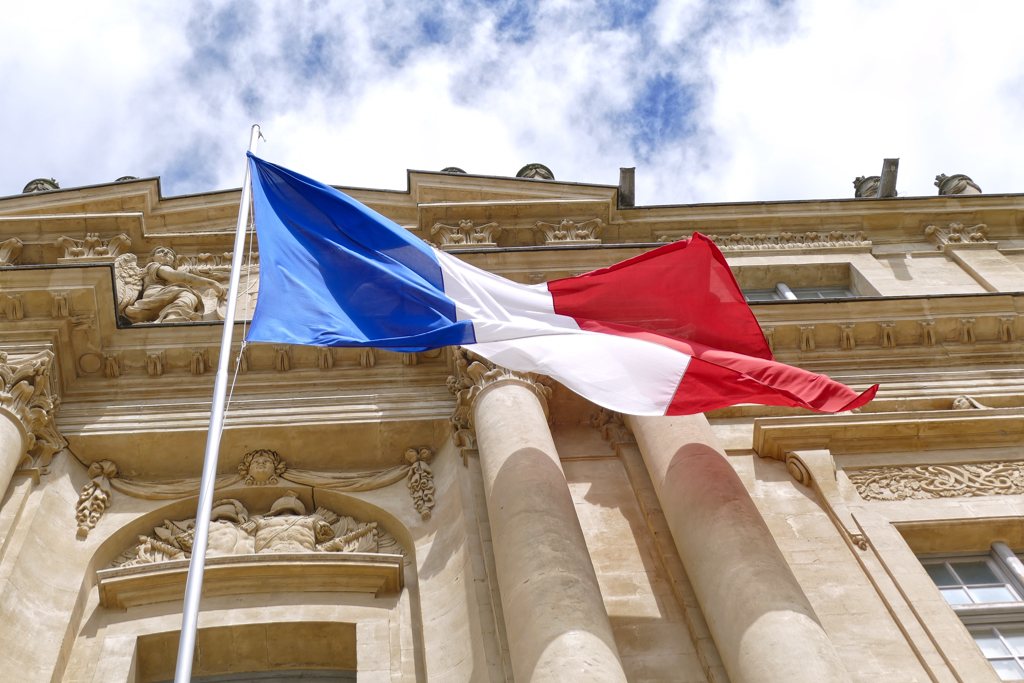
The French are famous for many great things. Presumably, speaking foreign languages is not one of those. While in über-touristy Paris, things seem to get a bit better, in the Provence region, people have rudimentary knowledge of English at most. And while they still might understand more or less what you are saying, they might not be able or willing to answer in English. Therefore, already out of respect, it won’t hurt to learn at least some polite phrases with the help of babbel or Lingohut, for example.
Map
This map should help you to find all the wonderful places I visited during my circle trip to five cities in the Provence region. Clicking on the slider symbol at the top left or the full-screen icon at the top right will display the whole map including the legend:
Cities I Visited
The detailed information on each of my stops is found in these posts






Pinnable Pictures
If you choose to pin this post for later, please use one of these pictures:

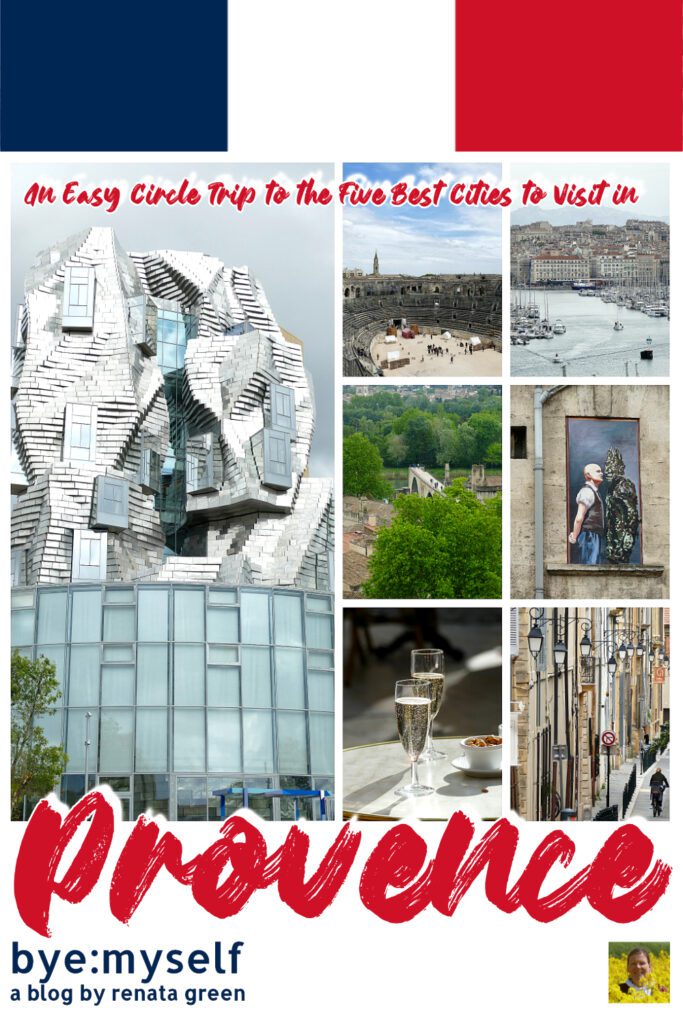
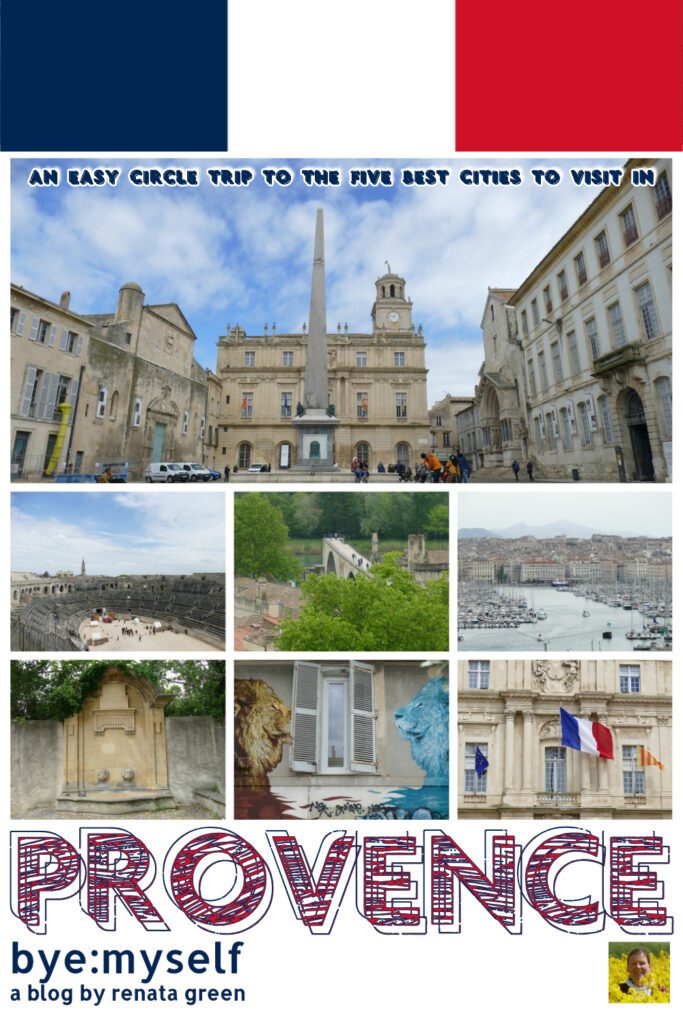



Note: I’ve thoroughly completed, edited, and updated this post in May 2025.
Did You Enjoy This Post? Then You Might Like Also These:
The Best Street Art in MARSEILLE
Best Places to Visit in Basse Terre, the Western Wing of GUADELOUPE (also by public bus)
24 hours in PARIS
One Day in NÎMES – What Not to Miss in the Most Roman City of France
10 Most Beautiful Palaces in the Marais Neighborhood of Paris
Two Days in MARSEILLE – What Not to Miss in the Belly of France
GUADELOUPE: Complete Guide And Perfect Itineraries (also for travels by public bus)
What Not to Miss in AVIGNON in One Day – Apart from Dancing on Bridges
* This is an affiliate link. Hence, If you book through this page, not only do you get the best deal. I also get a small commission that helps me run this blog. Thank you so much for supporting me!
Disclaimer: Aix-en-Provence Tourist Office supported my blogger trip by supplying me with information, an Aix-en-Provence City Pass, as well as accommodation. Also, L’Office de Tourisme d’Arles, Office du Tourisme de Nîmes, Avignon Tourisme, and Office de Tourisme et des Congrès de Marseille supplied me with complimentary CityPasses.
However, all opinions on all services are mine and weren’t by any means influenced by my cooperation partners.





